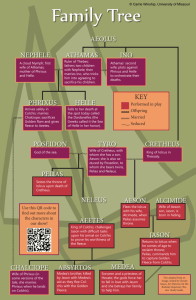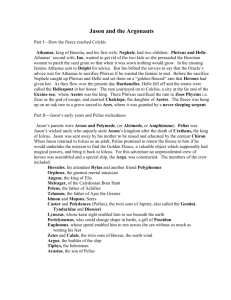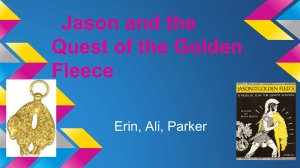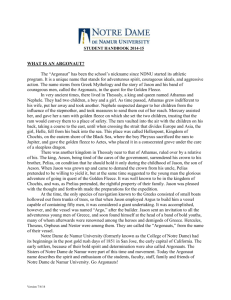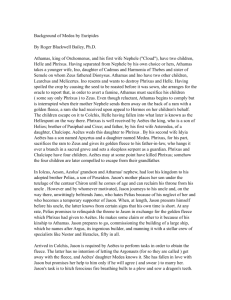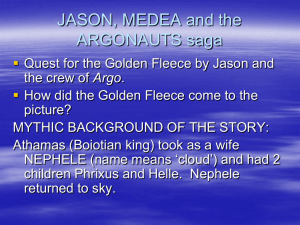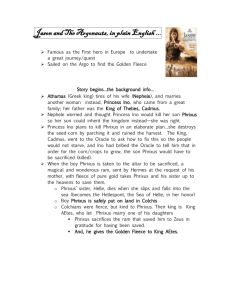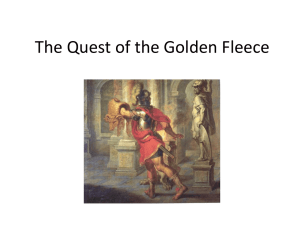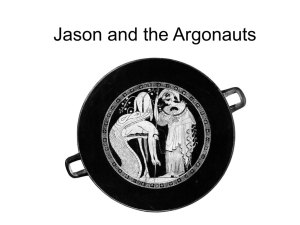jason and the argonauts
advertisement
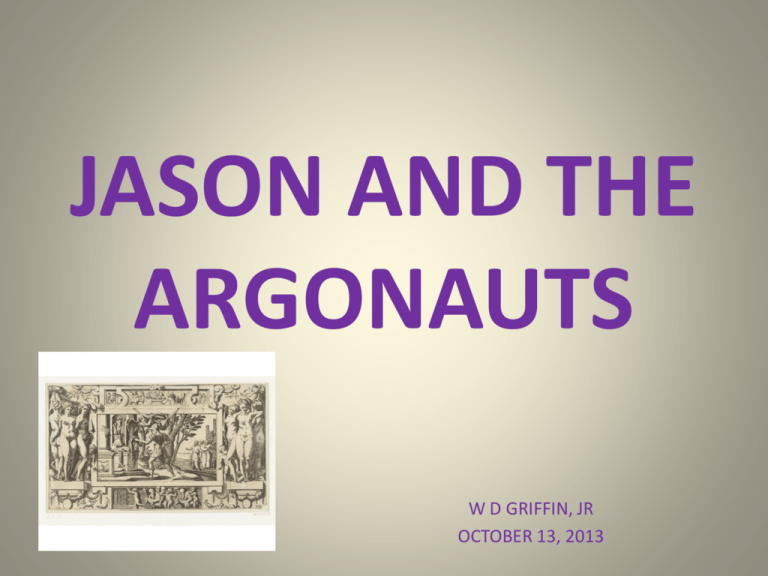
JASON AND THE ARGONAUTS W D GRIFFIN, JR OCTOBER 13, 2013 PART 1: THE GOLDEN FLEECE Athamas, king of Boeotia, married the cloud goddess Nephele (Cloud). She bore two children to Athamas, Phrixus and Helle; and returned to the clouds (some myths say that Athamas preferred Ino the daughter to Cadmus over her). Ino despised her stepchildren and persuaded the women to parch the grain, causing a famine. Athamas sent to the oracle at Delphi as to how to end the famine, but the envoys were bribed by Ino to say that only the sacrifice of Phrixus could end the famine. As Athamas was about to sacrifice Phrixus, Nephele sent a winged golden ram that gathered up both children and carried them to the eastern end of the Black Sea. THE GOLDEN FLEECE (cont’d) As the ram flew through the straits between Europe and Asia (Dardanelles), Helle fell from the ram. These straits are now called the Hellespont. Phrixus continued his flight until he arrive at Colchis on the eastern end of the Black Sea and stands on the Phasis River. Phrixus is received by Aeetes who is the son of Helius and brother of Circe and Pasiphae. Phrixus sacrificed the ram to Zeus and its fleece is hung from an oak tree in a grove sacred to Ares, guarded by a never-sleeping serpent. Aeetes gives Phrixus his daughter Chalciope in marriage and they have four sons: Argus, Melas, Phrontis and Cytisorus. PART 2: JASON AND PELIAS Cretheus, king of Iolcus, was the brother of Athamas. Upon the death of Cretheus, his stepson Pelias (son of Poseidon and Tyro) usurped the throne from Aeson (son of Cretheus and Tyro) the rightful heir and the father of Jason. Out of fear, Tyro sent Jason into the hills to be educated by the centaur Chiron and raised by Philyra, Chiron’s mother until he was 20 years old. Pelias knew that he would be slain by a descendant of Aeolus and was warned by the oracle at Delphi to be aware of a young man wearing only one sandal. JASON AND PELIAS (cont’d) When he came to the Anarus River, he met an old woman whom he carried across; and in doing so lost a sandal in the mud. The old woman was Hera who hereafter favored Jason; and was equally hostile to Pelias since he did not sacrifice to her. Upon demanding the throne, Pelias did not outright refuse the request, but promised him the throne if he would return the golden fleece. Pelias claimed that Phrixus had appeared to him in a dream and demanded that it be returned to Iolcus. PART 3: THE ARONAUTS In preparation for the expedition, the Argo (its name means swift) was built by Argus, son of Arestor. In the bow Athena place a piece of oak from the oracle of Dodona which had the power of speech. Two of the most famous were Orpheus and Heracles who deferred leadership to Jason. There were 50 members of the expedition (50 being the number of rowers necessary to power a Greek warship. THE ARONAUTS (cont’d) The most notable members included: King Augeus of Elis (who owned the stables cleaned by Heracles as one of his Labors); Meleager (Calydonian Boar Hunt); Peleus, father of Achilles; Telamon, father of Ajax the Greater; Oileus, father of Ajax the Lesser; and, Nauplius, father of Palamedes (used trickery to convince Odysseus to join the Greeks against Troy. Those with special talent included: the seers Idmon and Mospus; Castor and Poyldeuces the horseman and boxer respectively; Idas and Lynceus who could see beneath the earth; Periclymenus, the son of Neleus who could take whatever shape he liked in battle ( a gift from Poseidon); Euphemus who could run so quickly across the waves that his feet never got wet; Zetes and Calais the winged sons of the North wind Boreas; Argus the shipwright; and the helmsman, Typhis PART 4: THE VOYAGE TO COLCHIS--LEMNOS The first stop was Lemnos where the sailors found only women and the queen Hypsipyle. The women had neglected to worship Aphrodite who in turn made them unattractive to their mates who had turned their affections to Thracian concubines. The women killed every male on the island except for Thoas, the father of Hypsipyle who had saved him and escaped with the aid of Dionysus his father. The Argonauts remained on the island for one year. Jason and Hypsipyle had twin sons, Euneus and Thoas (Nebrophnus). After the Argonauts had departed, Hypsipyle was captured by pirates and sold into slavery under Lygurgus of Nemea but was later rescued by her sons and returned to Lemnos THE VOYAGE TO COLCHIS--CYZICUS After receiving the local mysteries of Samothrace, the Argonauts sailed to Cyzicus, the land of the Doliones and their king Cyzicus. They were well-received; and in return for their hospitality Heracles slew the giants who menaced the Doliones. When they set sail, contrary winds drove them back to Cyzicus. Thinking them to be a raiding party, the Doliones attacked. The Argonauts, not recognizing their friends, handily defeated them, killing Cyzicus. Once they realized their mistake, they helped to bury Cyzicus and mourned for him before setting sail again. THE VOYAGE TO COLCHIS--CIOS The next stop was Cios, farther eastward along the Propontis. They stopped for Heracles to replace a broken oar. Here Heracles’ companion was kidnapped by the nymph Dryope (not Apollo’s nymph). Heracles and Polyphemus searched for Hylas but to no avail. The Argonauts set sail without them. THE VOYAGE TO COLCHIS—THE BEBRYCES The Berbyces were a Bithynian tribe whose custom it was to make strangers box their king, Amycus. Amycus was a son of Poseidon and invincible. Polydeuces fought Amycus and killed him. The Berbyces attacked the Argonauts and were defeated with great losses. THE VOYAGE TO COLCHIS-SALMYDESSUS Here Phineus, a blind prophet, resided on the Euxine shore of Thrace. He is said to be the son of Agenor or Poseidon; and married to Cleopatra the daughter of Boreas (the North Wind). The reasons for his blindness include revealing the secrets of the gods (Zeus); blinding his sons by Cleopatra (Boreas); or preferring long life to sight (Helios). He is tormented by the Harpies (the Snatchers). Their names are Aello (storm swift), Celaeno (the dark), Podarge (fleet foot) and Ocypete (swift wing). Any time that a meal was placed before him the Harpies would fly down and snatch away most of the food, leaving the remainder inedible. Zetes and Calais chased them back to their home on the Strophades Islands (the islands of turning) where Iris, their sister, made them swear to never go near Phineus again. THE VOYAGE TO COLCHIS— SALMYDESSUS (cont’d) Phineus repaid the Argonauts by forewarning them of the potential dangers, especially the Symplegades (clashing rocks) near the entrance to the Black Sea. As ship attempted to pass through them, they would clash together, driven by the winds. It was fated that they should remain fixed if any ship was successful in passing through them. Phineus advised the Argonauts to release a dove at the entrance of the Symplegades. If the dove was able to pass through unharmed, then they should move through as the rocks recoiled; if not, then they should turn around. The dove made it through with the aid of Hera (or Athena); and the Argonauts were successful in passing through, losing only a piece of an ornament on the stern ending the dangers of the Symplegades. THE VOYAGE TO COLCHIS—THE REMAINING STOPS Their next stop was Mariandynia whose king was Lycus who treated them with great hospitality. Here the seer Idmon was killed by a boar and the helmsman Tiphys died after a short illness. Tiphys is replaced by Ancaeus the son of Lycurgus. They sailed past the land of the Amazons and the iron-working Chalybes. They next came to the Island of Ares where the Stymphalian birds had been chased by Heracles in his sixth Labor. They clashed their shields to keep the birds away as they rescued the sons of Phrixus who had attempted to sail from Colchis to Boeotia who also proved to be of little help upon arriving in Colchis. PART 5: JASON AT COLCHIS Aeetes was not friendly toward Jason, nor was he willing to part with the golden fleece. He was “willing” to give Jason the fleece only if he performed a series of impossible tasks. First he must yoke a pair of firebreathing bulls with brazen (brass) hooves which were a gift to Aeetes from Hephaestus. Next he must plow a field and sow the teeth of the dragon of Thebes which had been a gift from Athena to Aeetes. From these teeth armed men would spring up from the ground which he must defeat in battle. Here both Hera and Aphrodite caused Medea, the daughter of Aeetes, to fall in love with Jason. JASON AT COLCHIS (cont’d) When Chalciope approached Medea on Jason’s behalf at the request of Argus, Medea was willing to assist Jason. Medea was a priestess of Hecate and a witch. Her skill in magic allowed her to create an ointment to protect him. Jason met Medea at the shrine Hecate and gave him the ointment to protect him from both the flames of the bulls and the weapons of the sown men for one day. Jason performed yoked the bulls, plowed and sowed the field and, like Cadmus, threw a stone into the middle of the sown men who fell among themselves and slew each other. JASON AT COLCHIS (cont’d) Aeetes still had no intention of handing over the fleece to Jason, but planned to kill the Argonauts. Medea advised Jason to take the fleece himself and escape immediately. With Medea’s help Jason found the fleece, drugged the serpent that guarded it and fled Colchis with it. The Argonauts set sail taking Medea and her younger brother, Apsyrtus, with them. Medea used Apsyrtus to delay Aeetes by cutting him into pieces and throwing them into the sea which Aeetes stopped to collect for a proper burial. PART 6: THE ARGONAUTS RETURN There are four accounts of their return. First, they simply sailed back to Iolcus they way that they had come. The second implies that they sailed up the Phasis River until they reached the River of Ocean (Oceanus). From here they sailed south and west to Africa where they carried the Argo for 12 days until they reached the Mediterranean and sailed home THE ARGONAUTS RETURN (cont’d) The third version has them sailing up the Phasis through Russia to the Northern Seas around Britain and back through the Pillars of Heracles to the Mediterranean and home. The most common version from Apollonius Rhodius is that they sailed up the Ister (Danube) River. Next they crossed overland to the Adriatic Sea where they were confronted by Colchians and forced to sail up the Eridanus (Po) River into the Rhone and from there to the Mediterranean Sea. THE ARGONAUTS RETURN (cont’d) At the Mediterranean the speaking oak of the Argo warned them of the wrath of Zeus over the murder of Apsyrtus; and, if they did not wish to wander incessantly, then they must seek purification by Circe. They sailed to Aeaea and were purified by Circe and afterwards sailed past the Planctae (another set of clashing rocks), Scylla and Charybdis, the Sirens and to Corcyra, the land of the Phaeacians, where Jason and Medea were married. From here they were driven southward to Libya and were stranded on the shoals of the Syrtes (these were shipping hazards in the Mediterranean). They carried the Argo for 12 days to Lake Tritonis past the garden of the Hesperides. Mospus was lost to them on this journey after being bitten by a snake. The sea-god Triton guided them back to the Mediterranean. THE ARGONAUTS RETURN (cont’d) One last adventure remained on the return voyage. The island of Crete was guarded by the bronze giant Talus who walked around the island three times a day, hurling rocks at strangers to keep them away. Talus was said to have been made by Hephaestus and a gift of Zeus to either Minos or Europa. His life depended upon a bronze nail (or membrane) that closed the entrance to a vein above one ankle which, if opened, would allow the ichor (the blood to the gods) to flow out and cause his death. This occurred either because Medea drugged him and removed the nail; Poeas shot him in the ankle; or, he grazed his ankle on a rock and removed the membrane THE ARGONAUTS RETURN (cont’d) The Argonauts finally returned to Iolcus; and Jason gave the fleece to Pelias. The Argo itself was dedicated to Poseidon by Jason at the Isthmus and docked on dry land. Many years later while resting in the shadow of the Argo a piece of timber from the stern fell off and struck Jason in the head, killing him. PART 7: JASON AND MEDEA IN GREECE Once back in Greece, Medea used her magic to restore Aeson back to his youth by cutting him into pieces and boiling him in a cauldron using certain herbs. She added to the scene by restoring an old ram into a lamb, thus persuading the daughters of Pelias to do the same for him, but omitting the herbs. Thus they killed their own father. Jason had gained his vengeance on Pelias for not honoring his agreement, but was still deprived of the throne being defiled by the murder of Pelias. He and Medea were driven from Iolcus by Acastus, the son of Pelias, to Corinth. Several years later, Jason divorced Medea and married Glauce, the daughter of the king of Corinth. Medea sent by her two children a robe and crown smeared with a poisonous ointment which burned Creon and Glauce to death when they put them on. JASON AND MEDEA IN GREECE (cont’d) Medea then killed her two children as a final act of vengeance against Jason and escaped to Athens in a chariot drawn by winged dragons, a gift from her grandfather, Helios. Jason lived in misery in Corinth until his death. Medea was given asylum in Athens by Aegeus, the father of Theseus, by whom she became the mother of Medus. Later, she nearly caused Aegeus to poison his son Theseus. Failing in this plot she fled with Medus to Persia where her son founded the kingdom of Media. It is said that Medea eventually returned to Greece, but the remainder of her myth is lost. REFERENCES Gayley, Charles Mills. The Classical Myths in English Literature and in Art. New York: Blaisdell Publishing Company, 1963. Hamilton, Edith. Mythology. New York: Grand Central Publishing, 2011. Morford, Mark P. O. Classical Mythology. New York: Longman, Inc., 1977. Ovid. Metamorphoses. New York: Signet Classics, 2009. Tripp, Edward. The Meridian Handbook of Classical Mythology. New York: Penguin Books, 1974. www.wikipedia.org/greek mythology. 2014.
